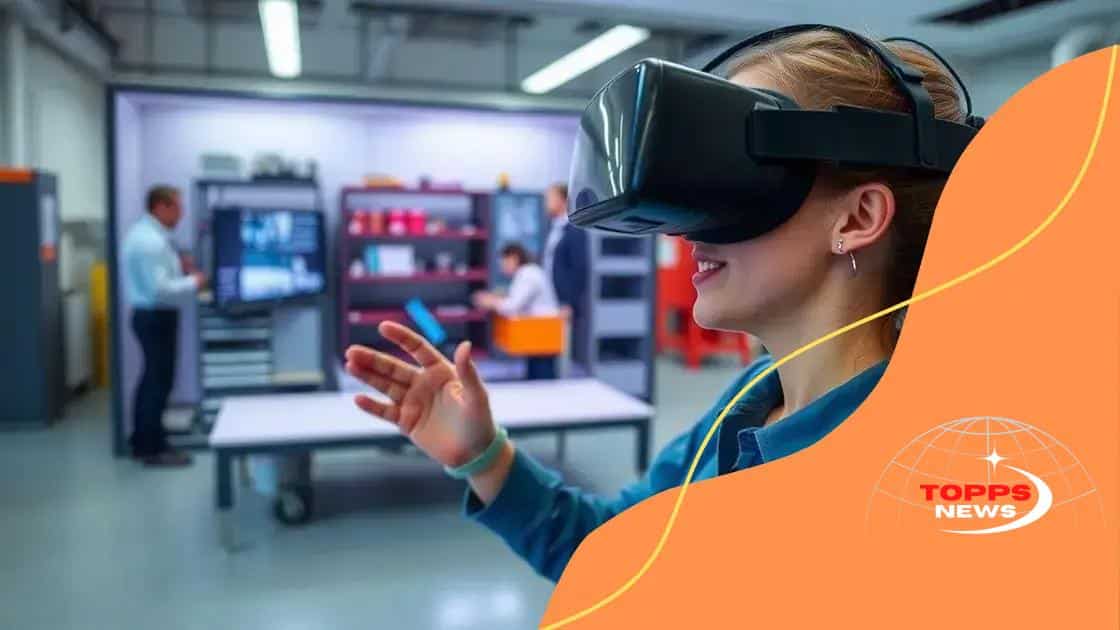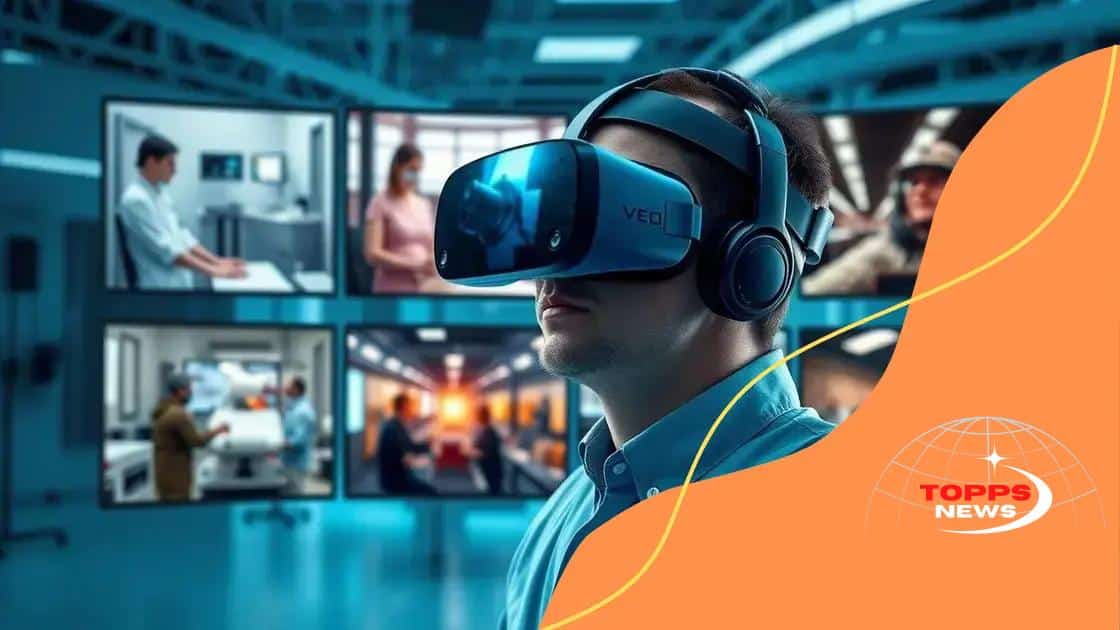Virtual reality’s role in workforce training is transformative

Virtual reality’s role in workforce training enhances employee engagement and skill retention through immersive experiences, making it an effective tool for various industries, including healthcare, manufacturing, and more.
Virtual reality’s role in workforce training is becoming increasingly significant. Imagine stepping into a virtual environment where you can practice skills safely. How could that reshape your career training experience?
Understanding virtual reality technology
Understanding virtual reality technology is essential for grasping its impact on workforce training. This innovative tool immerses users in a computer-generated environment, providing realistic simulations for hands-on learning. As companies adopt virtual reality, the potential for enhanced training experiences increases.
What is virtual reality?
At its core, virtual reality (VR) is a simulated experience that can mimic the real world or create an entirely new one. Users wear headsets that transport them into these environments. This technology allows individuals to engage with scenarios in a safe setting, where they can practice skills without real-world consequences.
Key components of virtual reality
Several elements work together to create effective VR experiences. Understanding these components enhances your appreciation of the technology:
- Headsets: Devices that provide immersive visuals, blocking out the real world.
- Tracking systems: Sensors that monitor the user’s movements and position within the virtual space.
- Controllers: Handheld devices that allow the user to interact with the virtual environment.
As organizations begin to incorporate virtual reality into training programs, they realize significant benefits. Improved engagement and retention of knowledge are common outcomes. Employees can practice complex procedures, troubleshoot equipment, or even engage in team-building activities within a virtual space.
The evolution of virtual reality
The journey of virtual reality technology started decades ago and has transformed into a vital asset for training. In the past, VR applications were limited, but ongoing advancements have made them more accessible and realistic. Companies in various fields, from healthcare to manufacturing, are now exploring VR to optimize their training processes.
Understanding this technology is a stepping stone to implementing it effectively. As VR continues to evolve, it opens up new avenues for enhancing workforce training, making learning more engaging and practical.
Benefits of virtual reality in training
The benefits of virtual reality in training are numerous and impactful. By immersing learners in realistic scenarios, VR enhances engagement and retention of information. This technology provides an opportunity to learn in a safe and controlled environment, where mistakes can lead to valuable lessons without real-world consequences.
Enhanced engagement
One of the most significant advantages is increased engagement during training sessions. Traditional methods can become stale, but virtual reality captivates users with interactive experiences. Learners are often more motivated and attentive when using VR, leading to better outcomes.
Realistic practice opportunities
Another essential benefit is the ability to practice skills in lifelike scenarios. This is particularly useful for complex tasks, such as medical procedures or heavy machinery operation. Trainees can gain experience by repeating actions until they achieve proficiency, making them better prepared for real-world situations.
- Safe environment: Mistakes do not have real-life consequences.
- Accelerated learning: Users can learn faster when practicing actively.
- Immediate feedback: Instant guidance helps improve skills quickly.
In addition to these advantages, virtual reality in training promotes collaboration. Teams can interact in the same virtual space regardless of their physical locations. This creates a stronger sense of camaraderie and encourages effective communication, which is crucial for successful teamwork.
Cost-effectiveness
Employers also find VR to be cost-effective in the long run. Although the initial investment may be high, the reduction in training time and improved performance can lead to significant savings. Companies can avoid costly mistakes and reduce training-related downtime, allowing employees to get up to speed more quickly.
Furthermore, the adaptability of VR allows organizations to update training programs easily. As procedures change or new technology emerges, modifications in the virtual environment can be made without the need for additional resources. This flexibility keeps training relevant and up-to-date.
Real-world applications of VR in workforce development

Real-world applications of VR in workforce development showcase the potential of this technology to enhance various training programs. From healthcare to manufacturing, virtual reality offers immersive experiences that prepare employees for their roles effectively. These applications are rapidly evolving, demonstrating the versatility and effectiveness of VR in diverse industries.
Healthcare training
In healthcare, VR is transforming how professionals learn essential skills. Trainees can practice surgeries or patient assessments in a controlled environment. This hands-on experience ensures they are better prepared for real-life situations, ultimately leading to improved patient care. For instance, medical students can rehearse complex procedures multiple times without risk to actual patients.
Manufacturing and equipment training
Manufacturing companies also benefit from VR workforce training. Employees can learn to operate machinery safely and efficiently without the hazards present in a real-world setting. VR allows workers to familiarize themselves with equipment before stepping onto the factory floor. This not only saves time but also reduces the likelihood of accidents.
- Simulated environments: Workers can train in realistic settings that mimic their job conditions.
- Skill reinforcement: Repeated practice in VR helps employees master tasks before actual implementation.
- Cost-effective training: Virtual simulations reduce the need for physical resources and materials.
Moreover, VR applications extend to other fields such as retail and hospitality. Sales teams can engage in role-playing scenarios, practicing customer interactions in lifelike environments. This not only boosts confidence but also enhances communication skills, ultimately improving customer service.
Military and tactical training
The military has long utilized VR for tactical training, providing soldiers with realistic combat scenarios. This enables them to practice strategic thinking and decision-making under pressure. By simulating high-stress situations, VR prepares service members for the challenges they will face in the field.
As companies continue to explore real-world applications of VR in workforce development, they uncover more possibilities. The technology is not just about training; it fosters innovation in learning and development strategies, pushing organizations to adapt and grow in an ever-evolving landscape.
Challenges in implementing virtual reality training
Challenges in implementing virtual reality training can impact organizations as they explore this innovative technology. While VR offers numerous benefits, several obstacles must be addressed for successful integration. Understanding these challenges is key to creating effective training programs.
High initial costs
One of the most significant challenges is the high initial costs associated with virtual reality technology. Headsets, software, and development can require substantial investments. Organizations must carefully assess their budgets and determine the return on investment before proceeding. However, while upfront expenses might be daunting, the long-term benefits often make it worthwhile.
Technical difficulties
Technical difficulties can also hinder the adoption of VR training. Hardware malfunctions, software bugs, and compatibility issues can frustrate both trainers and learners. Proper IT support is essential to ensure smooth operations. Training staff on how to troubleshoot common issues can help mitigate these problems.
- Ongoing maintenance: VR systems need regular updates and maintenance to function efficiently.
- User resistance: Some employees may be hesitant to embrace new technology. Support and training can help ease this transition.
- Content creation: Developing effective training modules requires skilled personnel, which may be challenging to find.
Furthermore, the learning curve for new users can pose a barrier as well. Familiarizing employees with the VR equipment and software takes time and effort. Encouraging employees to participate in training sessions can help build confidence and enhance their experience.
Adapting training content
Adapting existing training content to fit into a virtual reality format can be a complex task. Traditional training modules often need significant modifications to leverage the immersive aspects of VR. This process requires creativity and a deep understanding of both the content and the technology.
As organizations grapple with these challenges, it’s essential to remain optimistic. By addressing issues proactively and investing in proper training, companies can unlock the full potential of virtual reality training. Embracing these changes can lead to a more engaged and well-prepared workforce.
The future of virtual reality in workforce education
The future of virtual reality in workforce education holds exciting possibilities. As technology continues to evolve, VR is becoming increasingly integrated into training programs across various industries. This shift promises to enhance the way employees learn and develop skills.
Integration with AI technology
One significant trend is the integration of AI with virtual reality. Combining these technologies allows for personalized learning experiences. AI can track a learner’s progress and adapt scenarios based on performance. This tailored approach helps ensure that employees master the skills they need to be successful.
Expanding training scenarios
The range of training scenarios is also expected to grow. Future VR applications will cover a wider variety of skills and industries. For example, new sectors like remote work training can utilize VR to simulate virtual office environments, enhancing communication and collaboration skills.
- Collaborative training: Teams can train together in virtual spaces regardless of their physical location.
- Soft skills development: VR can help employees practice communication and teamwork in realistic situations.
- Continuous learning: As industries evolve, VR content can be updated swiftly to reflect the latest trends and techniques.
Another critical aspect of VR’s future in workforce education is cost-effectiveness. Although initial investments may be high, organizations can expect to save on training resources over time. Virtual simulations reduce the need for physical materials, travel, and downtime during training sessions. As more companies recognize these long-term benefits, the demand for VR solutions is likely to increase.
Enhanced accessibility
Accessibility is also improving, making VR training available to diverse workforces. Virtual reality is becoming more user-friendly and less expensive. This means even smaller organizations can implement VR training programs. As technology advances, more employees will have access to immersive learning experiences.
Moreover, remote and hybrid workforces are becoming the norm, reinforcing the importance of VR in education. Employees can continue developing their skills no matter where they are located. This flexibility is crucial for maintaining productivity and ensuring that companies remain competitive in the global market.
FAQ – Frequently Asked Questions about Virtual Reality in Workforce Education
How does virtual reality improve training for employees?
Virtual reality provides immersive experiences that enhance engagement and retention, allowing employees to practice skills in a safe environment.
What are the benefits of integrating AI with VR in training?
Integrating AI allows for personalized learning experiences, adapting training scenarios based on individual performance and progress.
Are there any challenges in implementing VR training?
Yes, challenges include high initial costs, technical difficulties, and the need for content adaptation to fit the VR format.
How can organizations prepare for the future of VR in workforce education?
Organizations can stay competitive by investing in VR technology, training staff properly, and adapting their programs to incorporate the latest trends.





